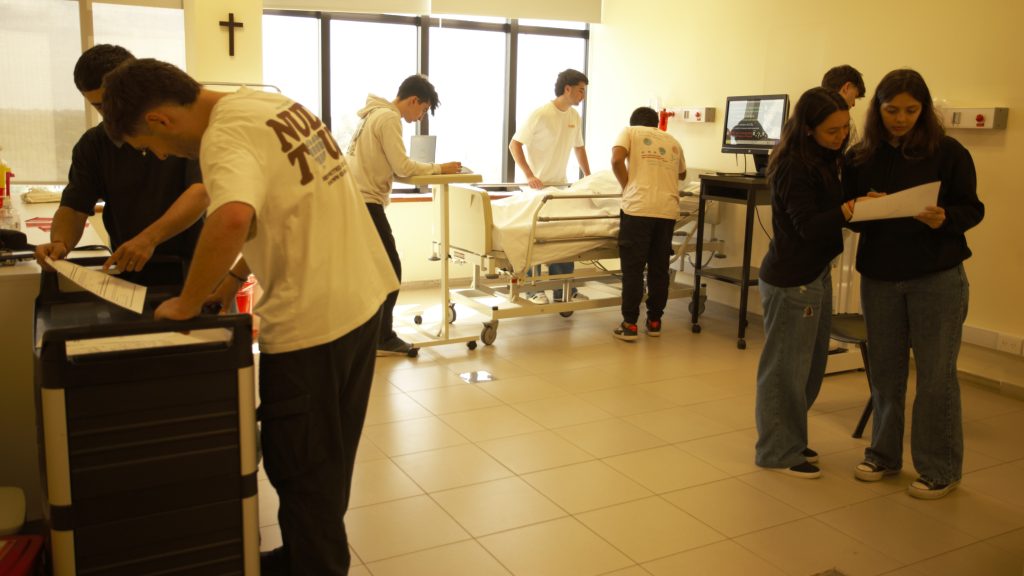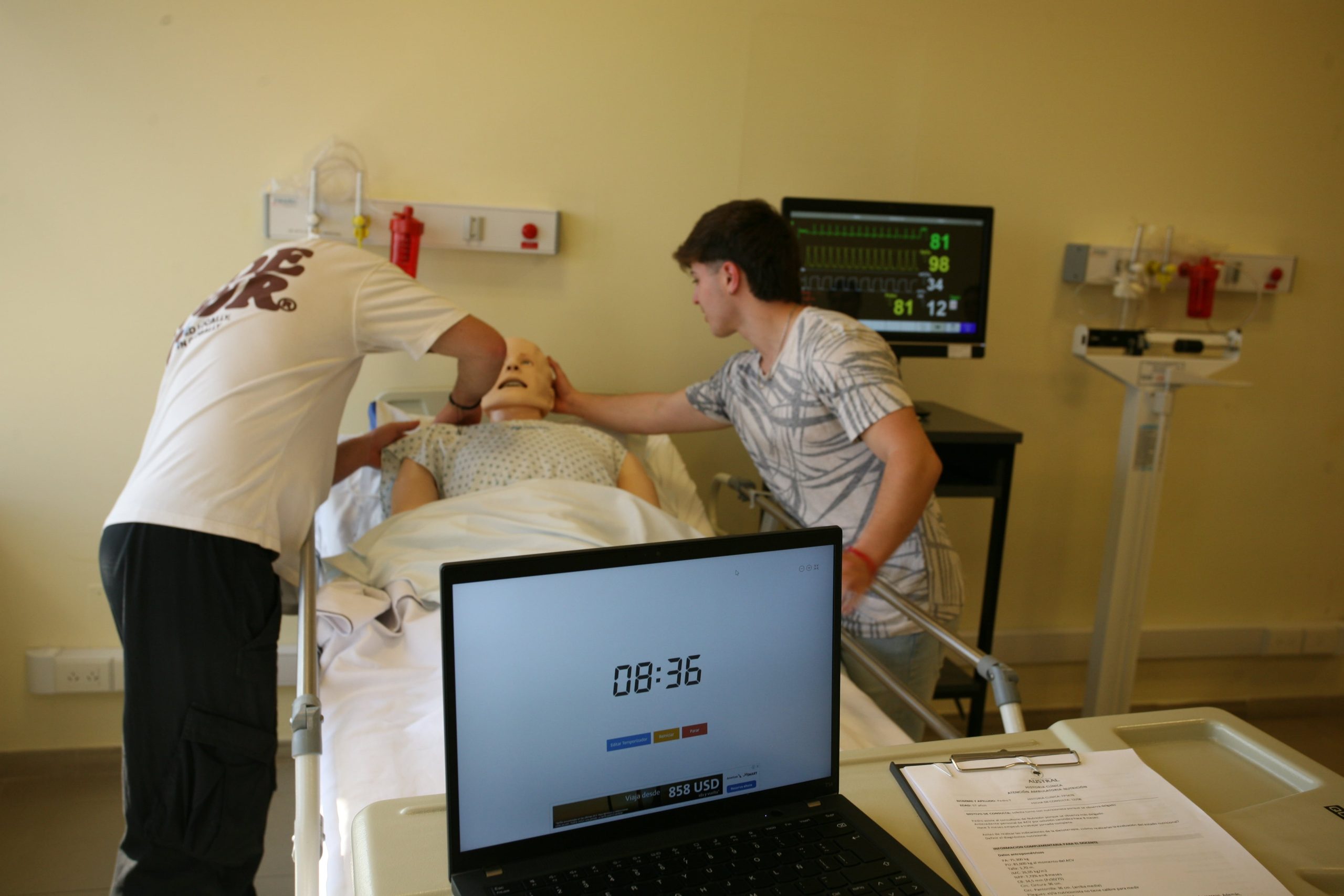Considered one of the best communications of the International Congress on Health Simulation and II Symposium on Health Simulation Operations held in Argentina last May, this article presents a clinical simulation-based escape game for Nutrition students at Universidad Austral. The activity, part of the subject ‘Food and Nutrition Assessment of Adults’, combined theoretical and practical knowledge with soft skills such as teamwork. The students had to stabilise a patient by simulating real clinical situations. The experience was positively valued, improving the understanding of the contents and motivation.
Introduction
In recent years, gamification has gained relevance as a teaching-learning methodology in higher education as it favours, among other things, student motivation. Strategies vary depending on the age of the students, access to technologies and pedagogical objectives. Escape games (EG) are based on creating scenarios where a group of people are trapped and, in order to get out, they must solve problem situations in a specific time. It promotes soft skills and allows the revision of theoretical-practical contents by presenting them as the necessary instructions to ‘escape’.
The aim of this paper is to present the design of an escape game based on the principles of clinical simulation (CS), aimed at students of Nutrition at Universidad Austral.
How we developed the escape game
In the subject ‘Dietary and Nutritional Assessment of Adults’ an EG was designed with the following learning objectives:
- to evoke and apply theoretical-practical concepts of the discipline in a playful space (technical objective)
- to coordinate tasks for greater efficiency in the resolution of the game (non-technical objective)
- communicate clearly, precisely and respectfully, in order to be assertive to the task (non-technical objective)
- develop a patient and cooperative attitude to encourage group participation (non-technical objective)
The EG, in addition to generating motivation and challenge, was designed according to the SC guidelines as it aimed to introduce the simulation training methodology and to bring students closer to the university’s SC centre, where the game was developed. The first step in designing the EG was to start from a game scenario: “Due to an emergency situation, doctors and nurses had to leave the hospital ward, asking the hospital nutritionists (students) to keep a patient (simulator) stable until their return. At the foot of the bed there is a sheet with the necessary instructions (patient position, oxygen therapy, pain medication, antihypertensive medication and patient safety). Instructions on how to implement these practices will be given when developing the instructions for the game’.

The planned game in clinical simulation
The game was prepared based on the University’s model for clinical simulation implementation (Latugaye, D, et al, 2024) which consists of 3 steps: before, during and after.
Before
Preparation
The subject content to be included in the game was selected. They were considered according to the degree of difficulty in application or interest in fixing the learning. Then, the activities were thought of according to whether they were intended to achieve a skill, a theoretical resolution or a synthesis of the concepts. The activities in the EG must have a guiding line in which the solution of some are the beginning for the resolution of others. In the game described, it was proposed:
- Perform nutritional screening
- Review anthropometry
- Recall the characteristics of the methods for assessing body composition
- Assess fat mass based on the tricipital fold
- Recognise techniques for measuring muscle function
- Consolidate the need to review the calibration of measuring instruments
Once the activities were designed in the form of puzzles, crossword puzzles, application of techniques, material resources were prepared, times were planned, and lifeguards were anticipated so that the students could advance in the game.
The game room was equipped with cameras and audio to be able to observe the dynamics of the game from outside and to communicate with the students if needed.
Prior to implementation, a pilot test was conducted with a group of teachers. With the limitation of not having been the target population of the activity (students), this instance functioned to review the activities and resources, as well as the facilities of the room.
On the day of implementation, before starting the game, the information to be given to the students about the game environment was prepared. This consisted of explaining the learning objectives, the objective of the game itself and the function of the simulator involved. Also, to explain that the EG is contextualised in an environment of confidentiality and respect, that mistakes will not be punished, but reflected upon, and that the use of the cameras is for academic purposes.
During
Development of the game
During the game, teachers stood outside the room so as not to intimidate the group of students. The teachers observed the development of the game and were attentive to provide the lifeguards provided to assist in the achievement of the objective. In addition, they conducted observation based on the learning objectives, recording every activity and action on the part of the students. The completion of the game was reached when the 5 planned practices were carried out, achieving clinical stability of the patient (simulator) or with the completion of the stipulated time.
Afterwards
Feedback or debriefing
A debriefing was planned after the end of the game. The teacher observers guided the reflection of the participating students. The reflection was developed in two different ways: focusing on the activities of the subject and giving feedback on each technique; or focusing on the group dynamics, in addition to the techniques, using debriefing strategies. In both cases, the student played an active role in analysing his/her participation and that of the group in relation to the learning objectives and opportunities for improvement.
Evaluation of the activity
In the overall evaluation survey of the subject, questions about the JE were included in order to know its implication in the understanding and fixation of the contents, as well as the dynamics developed.

Final comments
The activity was implemented for two consecutive years and, although the planning was respected in both years, differences were observed at the time of execution. The development of the game represented the group dynamics that emerged during the theoretical classes and the students also transcribed it in the evaluation.
Although all the students in both years agreed that the EG contributed to the integration of the contents, the first cohort, which presented difficulties in relating to each other, referred to comments such as: ‘[…] team work, listening to others and respecting each other’s opinion […]’, ‘[…] trying to learn to work in a team […] “ and ”[…] team work, logical thinking’. Whereas, in the next year group, the practice of technical skills for nutritional assessment was mainly valued: “It was good to be able to think on the spot what to do and to see what we remembered of contents. In addition, it allowed us to understand the aspects that had to be taken into account in the nutritional assessment in order to escape ‘ and “I found the way of remembering the knowledge very fun, it helped me to see things that I had not taken into account so much”.
The inclusion of EG as a teaching-learning strategy was positively valued not only by students but also by teachers. The EG proved to be an effective educational strategy for the pedagogical objectives set and also introduced students to clinical simulation.
Marcela Stambullian
Carrera Nutrición, Facultad de Ciencias Biomédicas, Universidad Austral
Betiana Leticia Peralta
Carrera Nutrición, Facultad de Ciencias Biomédicas, Universidad Austral
Carolina Astoul Bonorino
Centro de Simulación Clínica, Facultad de Ciencias Biomédicas, Universidad Austral
Guadalupe Vilar
Departamento de Educación Biomédica, Facultad de Ciencias Biomédicas, Universidad Austral
Dolores Latugaye
Centro de Simulación Clínica, Facultad de Ciencias Biomédicas, Universidad Austral
REFERENCES
O’Shea MC, Palermo C, Rogers GD, Williams LT. Simulation-Based Learning Experiences in Dietetics Programs: A Systematic Review. J Nutr Educ Behav. 2020; 52(4): 429-438.ad del paciente a los futuros profesionales y eso nos llena de satisfacciones como equipo.
Quek LH, Tan AJQ, Sim MJJ, Ignacio J, Harder N, Lamb A, Chua WL, Lau ST, Liaw SY. Educational escape rooms for healthcare students: A systematic review. Nurse Educ Today. 2024; 132: 106004.
van Gaalen AEJ, Brouwer J, Schönrock-Adema J, Bouwkamp-Timmer T, Jaarsma ADC, Georgiadis JR. Gamification of health professions education: a systematic review. Adv Health Sci Educ Theory Pract. 2021; 26(2): 683-711.
Fides-Valero A, Bray L, Dieckmann P, Antoniou P, Lahtinen P, Bamidis P, Nikolaidou M. Creating and running an escape room for healthcare curricula: AMEE Guide No. 168. Med Teach. 2024; 31: 1-12.
Latugaye D, Astoul Bonorino CM, Sánchez F, Capelli CM. Modelo de simulación clínica en 3 pasos: una iniciativa para guiar su implementación. Arch Argent Pediatr. 2024; e202410343
READ ALSO







































